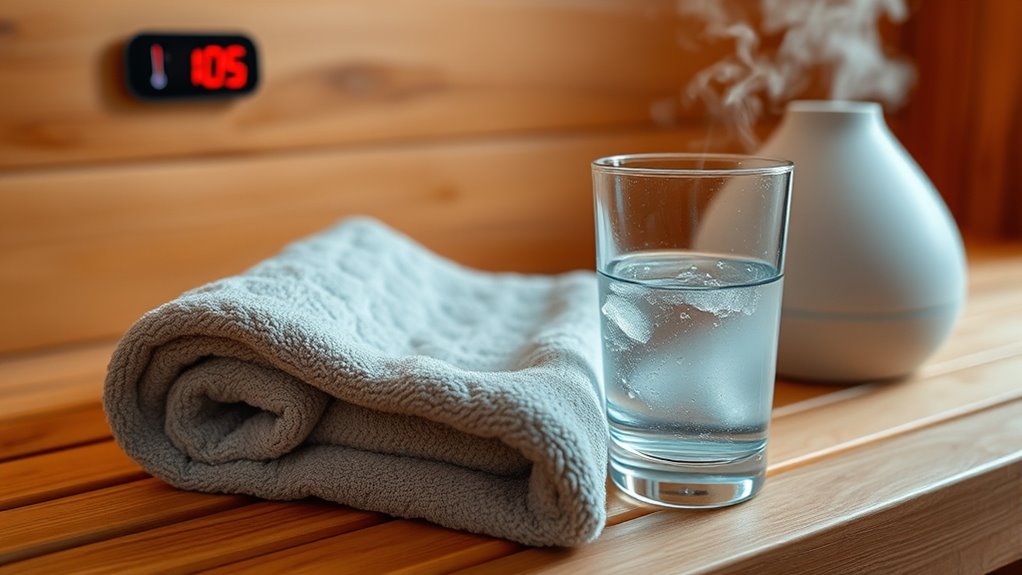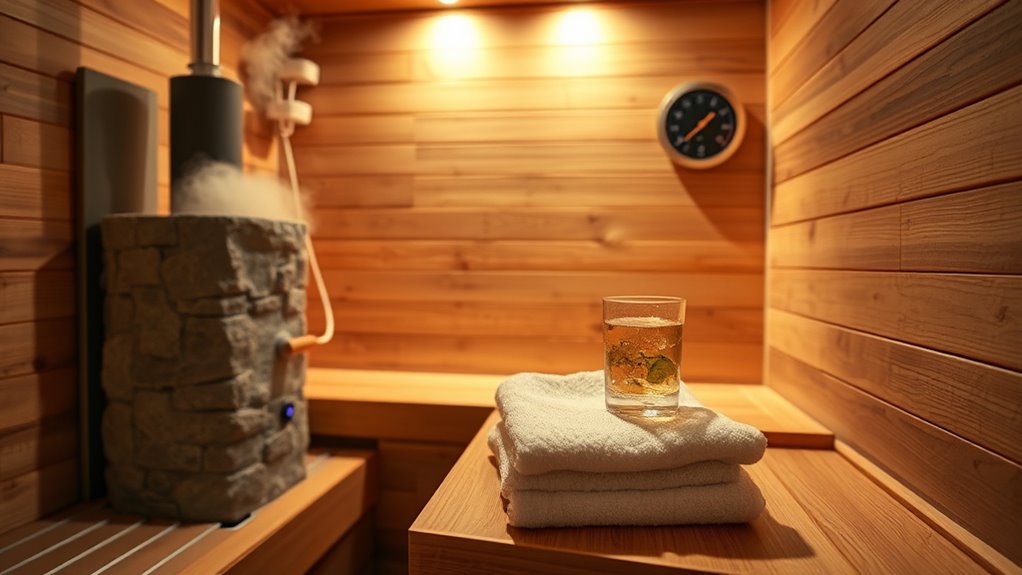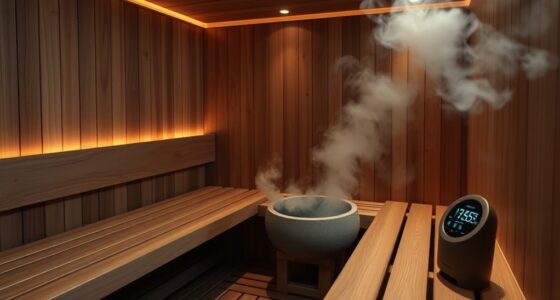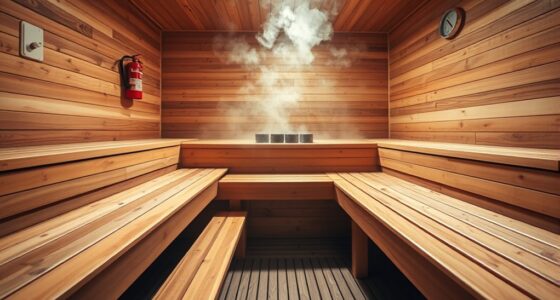To stay safe in the sauna, hydrate well before, during, and after your session. Limit your time to 15-20 minutes and wear minimal, breathable clothing or a towel. Avoid heavy or tight garments, and listen to your body—leave if you feel dizzy or uncomfortable. Maintain a clean environment and communicate if you need to slow down. Following these do’s and don’ts helps prevent overheating and dehydration, so you’ll enjoy the benefits safely; learn more tips to enhance your sauna experience.
Key Takeaways
- Do hydrate thoroughly before, during, and after sauna sessions to prevent dehydration.
- Do limit sessions to 15-20 minutes and listen to your body for signs of discomfort.
- Do wear minimal, breathable clothing or towels to promote safe heat circulation.
- Do gradually cool down after the session and rehydrate with water or electrolyte drinks.
- Not do stay longer than recommended or ignore signs of dizziness, nausea, or fatigue.
Preparing Safely for Your Sauna Session

Before you step into the sauna, it’s important to prepare your body and environment to guarantee a safe and enjoyable experience. Start with hydration tips: drink plenty of water beforehand to prevent dehydration, and keep a water bottle nearby to sip during your session. Your clothing choices matter too; opt for lightweight, breathable fabrics or go nude if the sauna allows, to promote better heat circulation and comfort. Avoid heavy or restrictive clothing, which can trap heat and make you feel uncomfortable. Make sure the sauna environment is clean and at the right temperature. Proper preparation ensures you maintain safety, reduce risks, and maximize relaxation during your session. Being mindful of hydration and clothing sets the foundation for a healthy sauna experience. Additionally, understanding how heat therapy influences your body’s response can help you tailor your session for optimal benefits.
Do’s and Don’ts During Your Sauna Experience

To guarantee a safe and enjoyable sauna session, it’s essential to follow some key do’s and don’ts. First, prioritize hydration tips by drinking water before, during, and after your session to prevent dehydration. Second, adhere to clothing guidelines—wear minimal, breathable clothing or a towel to allow your skin to breathe and avoid overheating. Third, avoid staying in the sauna too long; limit sessions to 15-20 minutes to prevent heat exhaustion. Remember to listen to your body and exit immediately if you feel dizzy, nauseous, or uncomfortable. Staying hydrated and respecting the right clothing guidelines help you maximize benefits while minimizing risks. Additionally, understanding the art of communication involved in conveying your comfort levels can enhance your safety. Following these simple do’s and don’ts keeps your sauna experience safe, effective, and enjoyable.
Post-Sauna Care and Monitoring

After your sauna session, it’s important to gradually cool down and rehydrate to help your body recover properly. Use hydration tips like drinking water or electrolyte-rich drinks to replace lost fluids and minerals. Pay close attention to how you’re feeling—monitor your health closely for signs of dizziness, dehydration, or fatigue. Rest in a cool space if needed, and avoid jumping into cold showers immediately, as sudden temperature changes can strain your body. Consider checking your pulse or blood pressure if you feel lightheaded or unwell. Proper post-sauna care guarantees you stay safe and reap the benefits without side effects. Remember, listening to your body and monitoring your condition is key to a safe, enjoyable sauna experience. Additionally, understanding the importance of contrast ratio can help you optimize your sauna environment for comfort and safety.
Frequently Asked Questions
How Long Should I Initially Stay in a Sauna as a Beginner?
As a beginner, you should start with a sauna duration of about 5 to 10 minutes. Follow beginner guidelines by listening to your body and avoiding overexertion. It’s important to stay hydrated and take breaks if you feel dizzy or uncomfortable. Gradually increase your time as you become more accustomed to the heat, but never push beyond your comfort zone. Always prioritize safety and your personal well-being during each session.
Can I Bring Beverages or Snacks Into the Sauna?
You shouldn’t bring beverages or snacks into the sauna, as it’s generally poor sauna etiquette and can be unsafe. While some believe hydration helps, the high heat can cause spills or burns, especially if drinks are hot or sugary. To stay safe and respectful of others, enjoy your beverages outside the sauna. Prioritize beverage safety by avoiding liquids that could cause messes or accidents in the hot environment.
Are There Specific Health Conditions That Prohibit Sauna Use?
If you have heart conditions or skin infections, you should avoid sauna use unless your doctor says it’s safe. Heart issues can be strained by the heat, and skin infections could worsen or spread. Always consult your healthcare provider before entering a sauna if you have any health concerns. Your safety comes first, so listen to your body and follow medical advice to prevent complications.
What Are Signs of Dehydration During or After Sauna Use?
You might notice dehydration signs during or after sauna use, like persistent fatigue symptoms. Imagine someone feeling dizzy and weak after a session; this could signal electrolyte imbalance caused by fluid loss. Other signs include dry mouth, headache, or dark urine. If you experience these, stop sauna use, hydrate with water or electrolyte drinks, and rest. Recognizing these symptoms helps prevent serious health issues and maintains your safety.
How Often Should I Schedule Sauna Sessions for Health Benefits?
You should schedule sauna sessions 2 to 3 times a week for ideal health benefits. Focus on frequency planning by spacing out your sessions to avoid overdoing it, and pay attention to session timing—limit each session to 15-20 minutes. Listen to your body, stay hydrated, and gradually increase the frequency if you feel comfortable. This approach helps maximize benefits while minimizing risks.
Conclusion
By following these safety tips, you guarantee a relaxing and healthy sauna experience. For example, imagine you accidentally stayed too long and felt dizzy—knowing to hydrate and exit promptly prevents this. Always listen to your body and respect your limits. With proper preparation, mindful behavior during your session, and careful post-sauna care, you can enjoy the benefits safely and comfortably every time. Your well-being should always come first.









